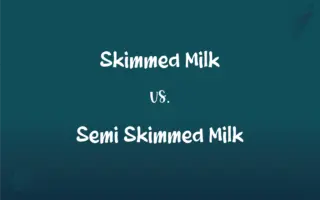Burger vs. Sandwich: What's the Difference?
Edited by Aimie Carlson || By Janet White || Published on December 1, 2023
A burger typically consists of a cooked patty inside a bun, while a sandwich involves any fillings between two slices of bread.

Key Differences
A burger is generally understood to be a specific type of sandwich consisting of a ground meat patty, usually beef, placed inside a split bun. Sandwiches, on the other hand, encompass a broader range of foods, where any variety of ingredients are placed between slices of bread, which can be of any type.
The primary distinction in a burger is its cooked meat patty, which is often grilled or fried, and the bun, which is typically soft and round. Sandwiches offer more diversity, ranging from simple fillings like ham and cheese to complex combinations, and can be made with various types of bread, including rolls, sliced bread, or baguettes.
Burgers are often associated with fast food and casual dining, and they commonly include toppings like lettuce, tomato, cheese, and condiments. Sandwiches have a broader culinary scope, found in both quick-service contexts and gourmet settings, with fillings that can be cold (like deli meats) or hot (like a grilled cheese).
In terms of cultural significance, the burger is iconic in American cuisine, often linked to quick, satisfying meals. Sandwiches have a more global presence, with each culture having its unique versions, like the Vietnamese Banh Mi or the Italian Panini.
Nutritionally, burgers, especially fast-food varieties, are often richer in calories and fat due to the meat patty and additional toppings like cheese. Sandwiches can range from high-calorie options to healthier alternatives, depending on the ingredients used, such as lean meats and vegetables.
ADVERTISEMENT
Comparison Chart
Base Ingredient
Cooked meat patty
Any variety of fillings
Bread Type
Typically a bun
Any type of bread
Common Context
Fast food, casual dining
Ranging from quick-service to gourmet
Cultural Significance
American cuisine
Global, with diverse cultural variations
Nutritional Range
Often higher in calories
Ranges from high to low calorie
ADVERTISEMENT
Burger and Sandwich Definitions
Burger
A fast-food item typically featuring beef, chicken, or veggie patties.
She opted for a veggie burger at the new diner.
Sandwich
A food item made with fillings between two slices of bread.
She packed a turkey and cheese sandwich for lunch.
Burger
A sandwich with a cooked meat patty inside a bun.
He ordered a cheeseburger with extra pickles.
Sandwich
Can be served cold, like a BLT, or hot, like a grilled cheese.
On a cold day, nothing beats a warm grilled cheese sandwich.
Burger
A popular American dish customizable with various toppings.
He customized his burger with avocado and bacon.
Sandwich
A versatile meal option, ranging from simple to gourmet.
The deli offered an array of sandwiches, from classic to exotic.
Burger
A grilled or fried patty, often beef, served in a split bun.
The restaurant's signature burger was a hit among customers.
Sandwich
Often includes vegetables, meats, cheeses, and spreads.
He enjoyed a roast beef sandwich with mustard and lettuce.
Burger
A casual meal option often served with fries and a drink.
They grabbed burgers and shakes for a quick lunch.
Sandwich
A staple in many cultures with various regional interpretations.
For breakfast, she often had a traditional Spanish bocadillo.
Burger
A sandwich consisting of a bun, a cooked beef patty, and often other ingredients such as cheese, onion slices, lettuce, or condiments. Often used in combination
A cheeseburger.
Sandwich
Two or more slices of bread with a filling such as meat or cheese placed between them.
Burger
A similar sandwich with a nonbeef filling. Often used in combination
A crab burger.
A tofu burger.
Sandwich
A partly split long or round roll containing a filling.
Burger
(informal) A hamburger.
Burger
A similar sandwich or patty.
Burger
A stereotypical well-off Pakistani aspiring to a westernized lifestyle.
Burger
An American.
FAQs
Can sandwiches be hot or cold?
Yes, sandwiches can be served either hot or cold.
Is a burger considered a type of sandwich?
Yes, a burger is a specific type of sandwich.
What makes a burger different from other sandwiches?
Its defining feature is the cooked meat patty inside a bun.
Can burgers be gourmet?
Yes, many restaurants offer gourmet burgers with unique ingredients.
Can vegetarian options be considered burgers?
Yes, veggie patties or other meat alternatives can be used in burgers.
Are sandwiches typically healthier than burgers?
They can be, depending on the ingredients used.
Can a burger be made without meat?
Yes, with alternatives like veggie, bean, or mushroom patties.
What is the origin of the hamburger?
The hamburger is believed to have originated in the United States.
Is bread type important in defining a sandwich?
Yes, but sandwiches can be made with a wide variety of bread types.
What is a slider?
A slider is a small, often mini-sized, burger.
Can sandwiches be a full meal?
Yes, especially when paired with sides like soup or salad.
What's a club sandwich?
A club sandwich is a type of sandwich with multiple layers, often including meats and lettuce.
Can burgers be part of a fine-dining menu?
Yes, some upscale restaurants feature high-quality, innovative burgers.
Are sandwiches part of global cuisine?
Yes, many cultures have their unique versions of sandwiches.
Are burgers usually served with sides?
Yes, often with fries, onion rings, or coleslaw.
Can sandwiches have sweet fillings?
Yes, like peanut butter and jelly sandwiches.
Is there a difference between a hoagie and a sub?
They are similar, both being long sandwiches, but the term varies regionally.
What are common sandwich spreads?
Mayonnaise, mustard, and butter are some common options.
Do burgers always have cheese?
No, cheese is optional and not required for a burger.
What's a patty melt?
It's a type of sandwich with a burger patty and cheese, grilled on bread.
About Author
Written by
Janet WhiteJanet White has been an esteemed writer and blogger for Difference Wiki. Holding a Master's degree in Science and Medical Journalism from the prestigious Boston University, she has consistently demonstrated her expertise and passion for her field. When she's not immersed in her work, Janet relishes her time exercising, delving into a good book, and cherishing moments with friends and family.
Edited by
Aimie CarlsonAimie Carlson, holding a master's degree in English literature, is a fervent English language enthusiast. She lends her writing talents to Difference Wiki, a prominent website that specializes in comparisons, offering readers insightful analyses that both captivate and inform.




































































